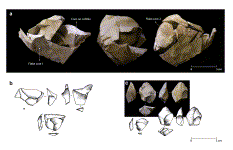Alain Turq, Wil Roebroeks, Laurence Bourguignon, Jean-Philippe Faivre
Source - http://www.sciencedirect.com/science/article/pii/S0047248413001899
Journal of Human Evolution, Volume 65, Issue 5, November 2013, Pages 641–655
Abstract
The importance of the transport of stone artefacts in structuring Neandertal lithic assemblages has often been addressed, but the degree to which this led to fragmentation of lithic reduction over Middle Palaeolithic landscapes has not been explicitly studied thus far. Large-scale excavations of Middle Palaeolithic open-air sites and refitting studies of the retrieved assemblages have yielded new, high-resolution data on the mobile aspects of Neandertal stone tool technology. In this paper, we integrate lithic technology and raw material data from recent studies of Middle Palaeolithic open-air and rock shelter sites in Western Europe. We demonstrate that the results of a variety of typological, technological (especially refitting), and lithological studies have important consequences for our knowledge of the acquisition of raw materials and subsequent production, usage and discard of stone artefacts in the Middle Palaeolithic. Neandertal production and use of stone tools was fragmented in three domains: the spatial, the temporal and the social domain. We show that this versatile segmentation of stone artefact handling strategies is a main determinant of the character of the Neandertal archaeological record. Our data testify to ubiquitous and continuous transport of stone artefacts of a wide variety of forms, picked by Neandertals using selection criteria that were sometimes far removed from what archaeologists have traditionally considered, and to some degree still consider, to be desired end products of knapping activities. The data presented here testify to the variability and versatility of Middle Palaeolithic stone tool technology, whose fragmented character created very heterogeneous archaeological assemblages, usually the product of a wide variety of independent import, use, discard and/or subsequent transport events.

Figure 1 . Location of the main Middle Palaeolithic sites discussed in the text

Flint artefacts from various rock shelters in the Périgord, testifying to transport and re-sharpening/re-use of non-local materials (Bergerac flint): 1, Handaxe (Pech-de-l'Azé I), 2, scraper (La Ferrassie), 3, tool on resharpening flake (Combe-Grenal), 4, denticulate tool made on a scraper (Combe-Grenal), 5, scraper made on a handaxe sharpening flake (La Rochette), 6, two refitted resharpening flakes (Combe-Grenal), 7, Large flake turned into core (Roc-de-Marsal).

Figure 3. ,Les Fieux, Ks: artefacts on non-local materials, recovered at ca. 30 km from their source 1, group of handaxe resharpening flakes, 2, Levallois flake, 3, scraper made on a handaxe-flake. See text for explanation.

Figure 4.
Les Fieux, couche I–J: (a) refitted block, reduced in discoidal debitage. It testifies to the fragmentation of on the spot reduction with a debitage on a block (core on cobble, elements shown in (b)) and, parallel to this, a debitage on flake-cores (refitted elements of flake core 2 shown in (c).